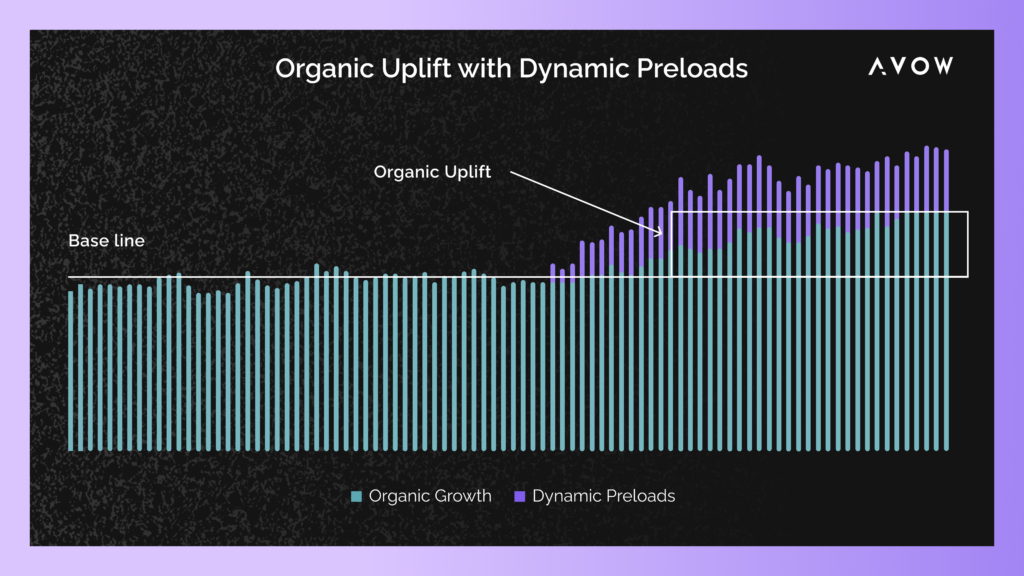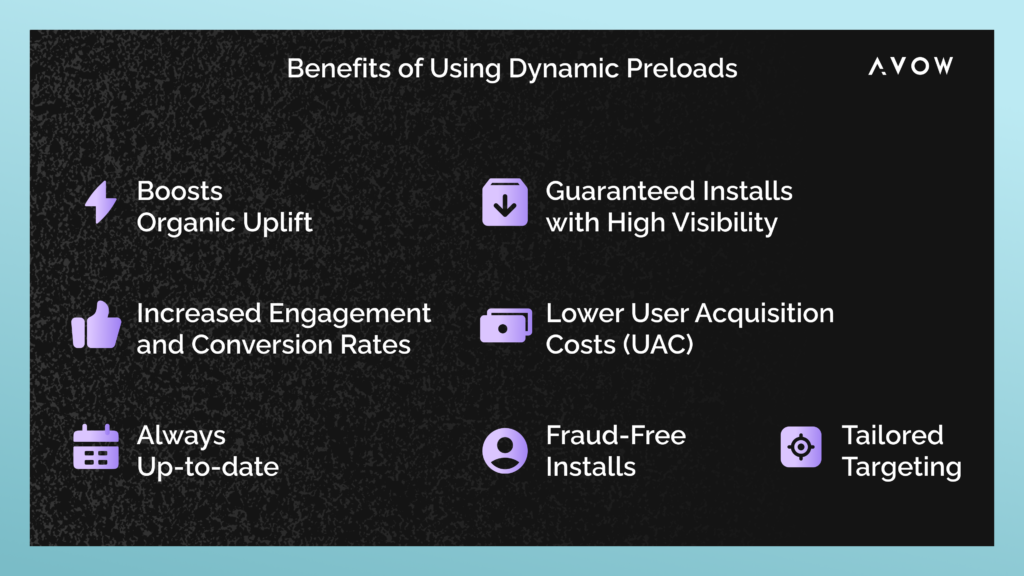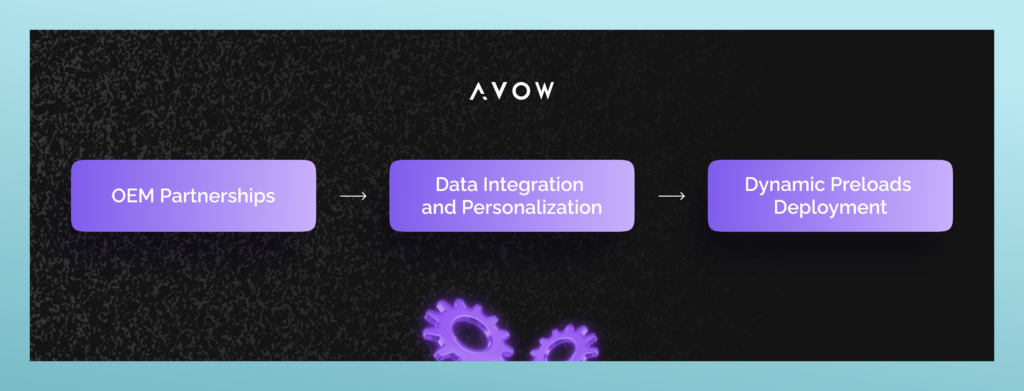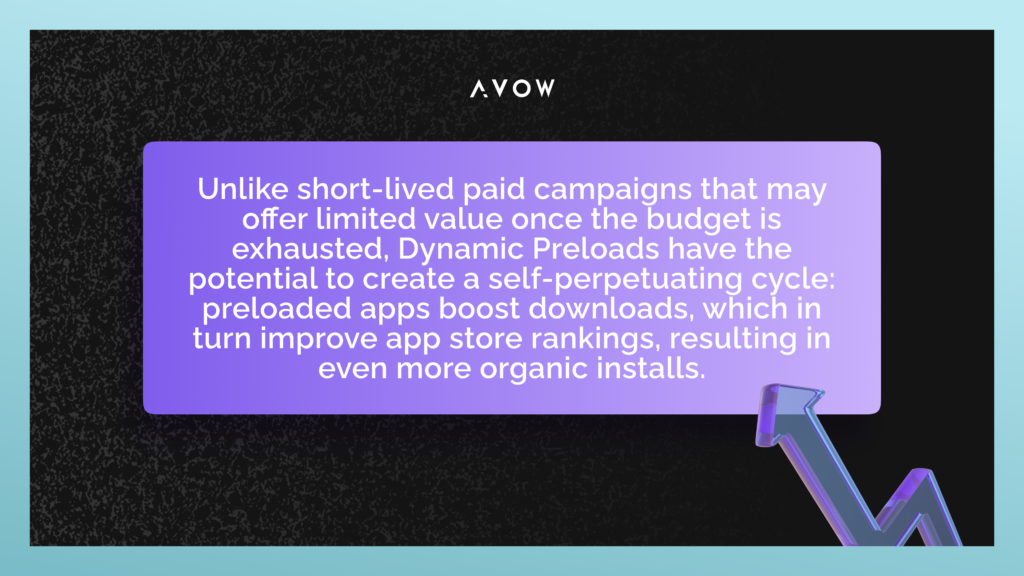Introduction
Achieving organic growth in today’s highly competitive app ecosystem is no small feat. With millions of apps vying for attention, app developers are finding it increasingly difficult to break through the noise and secure the organic numbers that once came more naturally. The organic install rate—the holy grail for sustainable app growth—has steadily declined as paid marketing tactics in the Google Play Store dominate the landscape, driving up acquisition costs while diminishing the opportunities for organic visibility.
App developers thus face a fundamental challenge: how do you drive organic growth with paid advertising?
Enter Dynamic Preloads, a strategic solution that offers a direct route to the user’s device, bypassing traditional app store bottlenecks. With Google Play Auto install’s ability to dynamically preload apps onto devices, it delivers guaranteed installs and catalyzes organic growth by enhancing visibility and driving user engagement. This solution addresses the core problem developers face—achieving organic uplift—by strategically positioning their apps in front of the right audiences, resulting in increased downloads and better app store rankings without the escalating costs of user acquisition.
This guide will explore how Dynamic Preloads, specifically through Google’s PAI (Play Auto Install) and mobile OEM partnerships, offer an effective strategy for organic uplift. With our exclusive data from real apps that have worked with AVOW, both gaming and non-gaming, this guide will help app developers navigate the complexities of the modern app marketplace whilst maintaining visibility.
Understanding Organic Uplift
In the world of mobile app marketing, organic uplift refers to the observed correlation between organic and non-organic installs. Essentially, when a paid campaign (non-organic installs) is executed successfully, it often leads to a boost in organic installs as well. This phenomenon occurs because paid campaigns drive greater visibility for an app, pushing it higher in the app store rankings, which in turn leads to increased discoverability and installs from users who were not directly targeted by the campaign.
What is Organic Uplift
Organic uplift can be understood as the incremental increase in organic installs that follows a surge in non-organic installs, often driven by paid user acquisition campaigns. For every app installed through paid methods, a certain percentage of users discover and install the app organically. The goal of any app developer is to achieve a strong multiplier effect—where paid installs not only boost paid performance but also trigger a cascading rise in organic growth.
Organic Uplift vs Incrementality: Which is it?
When it comes to these two terms, it is important to separate fact from fiction. In a nutshell, are these two terms interchangeable? Well, yes and no. While they do mean the same thing in a broader sense, and they both seek to explain a similar phenomenon, they both do differ in how they approach answering the question of organic growth.
In marketing terms, incrementality is usually defined as “organic growth that comes about from or after a paid campaign.” Sounds familiar right? But incrementality is more than just that. When it comes to marketing campaigns, incrementality is usually lead by the question, “Would I still have this organic growth if I DID NOT DO this paid campaign?’. In other words, incrementality is wondering if the same organic growth can be achieved organically or if that incrementality can be attributed to a particular paid campaign other than the one that is being observed or measured.
Organic uplift is a simpler metric to understand. It simply refers to the organic growth observed either during or after a paid campaign and is usually lead by the question, “Did my paid campaign lead to growth in my organic channels?”
The Decline of Organic Uplift
Over recent years, organic uplift has been on a steady decline. In its earlier years, the correlation between paid campaigns and organic installs was stronger, with well-executed paid efforts consistently driving significant organic growth. However, data from industry reports show that organic uplift has decreased by approximately 20% over the last few years, signaling a tougher landscape for app developers relying on organic growth strategies.
This decline is largely driven by increased saturation in app stores, with over 4.4 million apps available across the Google Play Store and Apple App Store as of 2024. As more apps compete for visibility, app store algorithms have evolved, giving more weight to factors such as user engagement and retention, not just installs. This shift has made it harder for paid campaigns to generate the same organic uplift they once did, especially as the market becomes flooded with apps.
Contributing Factors to the Decline in Organic Uplift
Four main factors stand out when it comes to the decline in organic uplift.
ASO vs Dynamic Preloads: Understanding the Differences
When comparing App Store Optimization (ASO) to Dynamic Preloads as methods of achieving organic uplift, key differences emerge.
That is not to say that ASO isn’t relevant or helpful. But it’s effectiveness has been severely hampered in this new era of the mobile app landscape. However all hope is not lost. If your budget alllows for it, a combination of Dynamic Preloads and ASO could elevate your app’s organic discovery and installs into a stratosphere all on it’s own.
Dynamic Preloads: A Proven Solution
Google PAI Dynamic Preloads have emerged as a powerful tool for app developers looking to enhance their visibility and achieve meaningful growth without relying solely on paid user acquisition campaigns. This approach provides an efficient, direct route to placing apps on users’ devices, driving both guaranteed installs and organic uplift. But how exactly do Dynamic Preloads differ from traditional preloads, and why are they considered a game-changer in the world of mobile marketing?
How Dynamic Preloads Work
Dynamic Preloads involve placing an app onto a user’s device during critical stages, such as during a software update or at the moment the device is first activated. Unlike traditional preloads, where apps are embedded into the device at the factory level and remain static, Dynamic Preloads are more flexible. They allow apps to be installed on the device post-manufacture, during periods when users are actively setting up or updating their device.
Dynamic Preloads are extremely easy to understand and require only a few simple steps for the user:
Dynamic Preloads: Easy As PAI
Traditional preloads are typically fixed and cannot be adjusted once they are shipped with the device. While effective in getting the app in front of users, they lack flexibility, personalization, and are always out-of-date. Dynamic Preloads, however, offer a much more targeted and adaptable approach, ensuring that apps are delivered to users based on their region, device type, and even seasonality. This method taps into moments when users are most likely to explore new apps, offering a higher chance of interaction and engagement. Since the app is downloaded directly from the Google Play Store, users are guaranteed to get the latest version of the app, complete with feature updates and bug fixes. This can have a significant impact on first impressions, and thus user engagement and retention.
Benefits of Using Dynamic Preloads
Dynamic preloads present several advantages over both traditional preloads and paid user acquisition campaigns. Here are several major benefits.
1. Guaranteed Installs with High Visibility
Dynamic preloads ensure that an app is delivered directly to the user’s device, bypassing the noise of app stores and allowing developers to secure installs without competing for attention. Once the app is preloaded, it enjoys prime real estate on the device, giving it far greater visibility than through standard app discovery channels.
2. Boosts Organic Uplift
As apps delivered through Dynamic Preloads enjoy heightened visibility, the knock-on effect is often an organic uplift, where users can discover the app easier through the app store, increasing organic downloads in the process.
3. Increased Engagement and Conversion Rates
By delivering apps at optimal moments—like during initial device setup or post-update phases—Dynamic Preloads ensure users are more likely to explore and engage with the app. Since users are actively making the choice to install the app, the likelihood of them using the app increases, leading to higher engagement and improved conversion rates compared to other user acquisition methods.
4. Lower User Acquisition Costs (UAC)
Dynamic preloads offer a cost-effective alternative to traditional paid user acquisition campaigns. While paid campaigns can result in high costs per install (CPI), especially in saturated markets, preloads ensure installs without bidding wars or fluctuating ad costs. This provides a more predictable and sustainable strategy for acquiring users, often at a significantly lower cost.
5. Always Up-to-date
Dynamic Preloads ensure your app is always on the latest updated version before the user even interacts with it, as the newest version of the app is downloaded directly from the Google Play Store during setup. This ensures the best possible first impression for the app.
6. Fraud-Free Installs
Dynamic preloads drastically reduce the risk of fraudulent installs, ensuring that every install is genuine and tied directly to a real device. This contrasts with the potential for fraud in more conventional advertising channels where bots and fake clicks can distort performance metrics.
7. Tailored Targeting
Unlike traditional preloads, Dynamic Preloads can be tailored to specific devices, regions, or even times. This precision ensures that the right apps are delivered to the right place at the right time, enhancing the preload’s overall relevance.
Technical Implementation of Dynamic Preloads
From a technical perspective, implementing dynamic preloads is relatively straightforward compared to traditional methods of app distribution. Here’s a brief overview of the process:
- OEM Partnerships: The first step in setting up Dynamic Preloads involves partnering with mobile Original Equipment Manufacturers (OEMs). OEMs such as Xiaomi, Oppo, Vivo, and Transsion enable the preloading of apps during device setups or updates through their custom software. Having OEM specialists like AVOW who can aggregate and act as a single point of contact for all the OEMs can be a mojor benefit for app developers looking to leverage Dynamic Preloads on multiple OEMs simultaneously.
- Dynamic Preloads Deployment: Unlike factory preloads, Dynamic Preloads are executed at a later stage, during device setup or subsequent software updates. OEMs integrate the preload directly into the device’s operating system, ensuring that the app is visible during crucial onboarding phases.
- Data Integration and Personalization: Dynamic preloads leverage data to ensure apps are relevant to the time, location, or device type. Through technical APIs and data integrations, apps can be targeted to specific devices based on geography or OEM partnerships.
Dynamic Preloads offer a proven and efficient solution for boosting app visibility, engagement, and organic uplift. By combining guaranteed installs with lower acquisition costs and higher relevance, they represent a valuable tool in the app marketer’s arsenal. In the following sections, we’ll explore real-world examples of organic uplift with Dynamic Preloads in action, focusing on the gaming and non-gaming verticals.
Organic Uplift Data
Dynamic Preloads (DP) through Google’s Play Auto Install (PAI), have demonstrated impressive results in driving organic growth across both gaming and non-gaming verticals. By offering a direct route to app installs, Dynamic Preloads not only ensure visibility but also boost organic downloads significantly. Let’s take a closer look at the performance data across different client campaigns in both gaming and non-gaming categories.
Gaming
Last year, US$240,000 was spent EVERY MINUTE on mobile games in mobile app stores. Thus every minute your mobile game spends away from the limelight can literally cost you. Here we take a look at two gaming apps that achieved sucesss with mobile OEMs and Dynamic Preloads.
These results clearly show the power of Dynamic Preloads in the gaming sector, where user acquisition costs are traditionally high, and organic growth is often challenging to achieve. The uplift in both organic and total installs indicates that users engage and opt-in to downloading preloaded apps, which then generates further organic discovery.
Non-Gaming
In non-gaming verticals, Dynamic Preloads have proven equally effective, offering a boost in organic downloads and total app installs. Below are the insights from two clients in different countries.
Key Takeaways
Across both gaming and non-gaming verticals, the results clearly indicate the power of Dynamic Preloads in boosting organic growth. The combination of guaranteed installs and increased visibility through Dynamic Preloads drives a meaningful uplift in organic downloads, ensuring that apps reach a wider audience while also lowering acquisition costs. The data suggests that this approach not only delivers short-term gains but also sustains long-term organic growth, making Dynamic Preloads an essential tool for app developers looking to break through the noise in today’s competitive app marketplace. For a deep dive into all things Dynamic Preloads, grab our dedicated guide here.
Uplift with Mobile OEMs: Not Just a One-trick Pony
Dynamic Preloads with Mobile OEMs offer much more than just a short-term boost in downloads. While it is clear that they can deliver impressive spikes in both organic and paid installs, the broader impact and long-term benefits of these campaigns should not be overlooked. Mobile OEM partnerships, in particular, present a well-rounded and sustainable strategy for developers looking to ensure organic uplift and remain competitive in an increasingly saturated app ecosystem.
1. Sustained Organic Growth
One of the core benefits of leveraging Dynamic Preloads with Mobile OEMs is the ability to maintain sustained organic growth well beyond the campaign’s initial period. As seen in the data earlier, organic installs tend to grow and maintain a steady organic uplift even during a 3-month-long campaign.
2. Impact on App Store Rankings
Preloads do more than generate immediate downloads—they help improve your app’s rankings within the app store, further amplifying organic uplift. The algorithms that govern app store rankings factor in both the volume of downloads and user engagement, meaning that an increase in downloads driven by preloads can significantly improve an app’s ranking. This higher ranking, in turn, boosts discoverability, leading to even more organic downloads over time.
3. Enhanced User Engagement and Retention
Apps delivered via Dynamic Preloads tend to see better engagement and retention rates as compared to those installed via traditional paid channels or factory preloads. Users are more likely to engage with apps dynamically preloaded on their devices as they feel the app is trustworthy due to the apps being presented as a recommendation from the OEM themselves. Furthermore, because users have to opt-in to download the apps via Dynamic Preloads, the user has made an active choice to engage with the app, something not available via traditional preloads. This leads to higher retention rates, as users perceive the app as part of their phone’s core functionality rather than a third-party download they might uninstall after a single use.
Additionally, dynamically preloaded apps have the advantage of immediate accessibility. Users don’t need to visit an app store, browse, or download the app—it’s already there, ready to be discovered when they explore their new device, as the apps are downloaded in the background while the user completes the rest of the setup. This ease of access can translate to higher in-app engagement rates and long-term loyalty, as the entire process is perceived to be value-adding as opposed to detracting from the experience.
4. Lower Acquisition Costs with Long-term ROI
Paid user acquisition campaigns often come with substantial costs, and their results tend to diminish once the campaign budget dries up. Dynamic Preloads, on the other hand, provide a lower-cost alternative with long-term benefits. By partnering with mobile OEM specialists like AVOW, developers can reduce their reliance on expensive models that often fail to deliver sustainable growth. AVOW provides advertisers with performance-based models, meaning advertisers aren’t just paying by cost-per-install (CPI) but rather with models such as cos-per-launch (CPL), where advertisers only pay when a user opens the app for the first time rather than simply installing the app via Dynamic Preloads.
5. Broader Reach Through OEM Ecosystems
Mobile OEM advertising opens the door to a vast and diverse audience, particularly in regions where OEMs dominate the smartphone market. For example, AVOWs partnerships with leading OEMs like Xiaomi, Samsung, Oppo, Vivo and Huawei provide access to over 1.5 billion daily active users globally. In markets such as Southeast Asia, India, and Africa, where mobile OEMs hold significant market share, Dynamic Preloads offer developers a way to reach untapped audiences that are often more cost-effective than traditional methods. Transsion alone, with brands such as itel, Tecno and Infinix under their umbrella, make up over half the entire African continent’s mobile market share.
Ready to Give Your App the Organic Uplift it Deserves?
The best time to have started with Dynamic Preloads was yesterday. The second best time to get started with Dynamic Preloads is today. So stop waiting, and start your app down a path to sustained organic uplift and immense growth right now! Our A-Team of mobile OEM advertising specialists are ready to make Dynamic Preloads as easy as “PAI” 😉.











